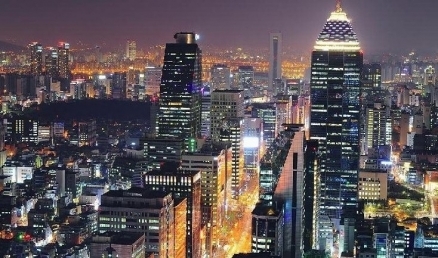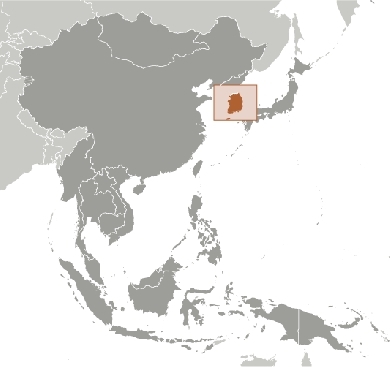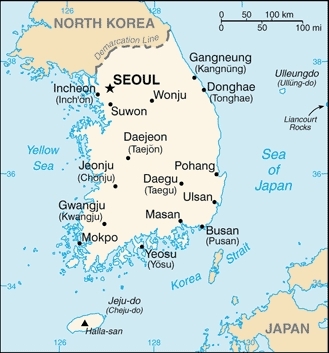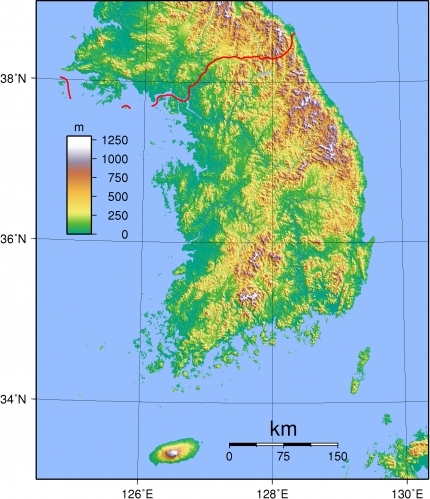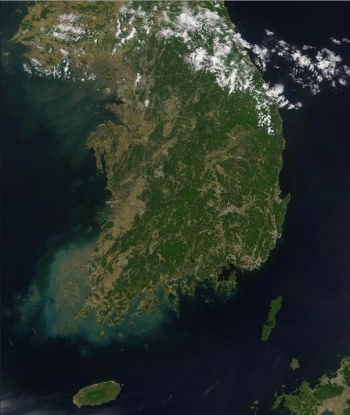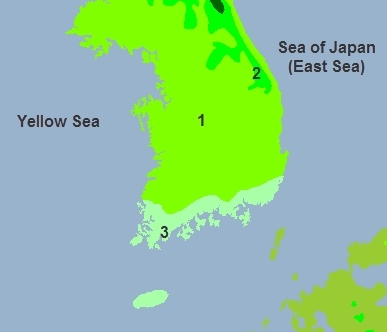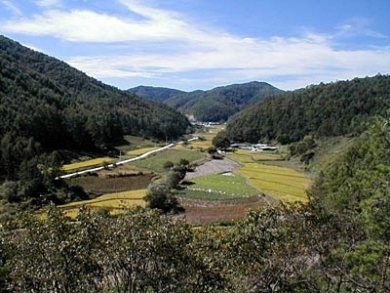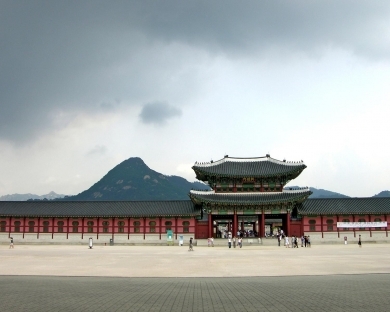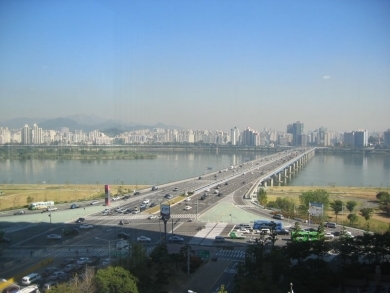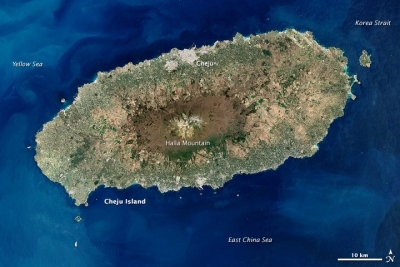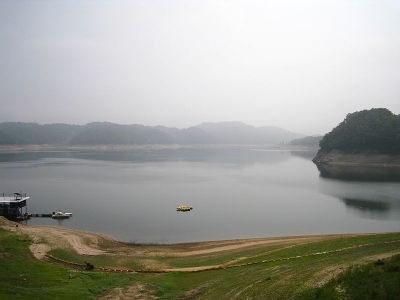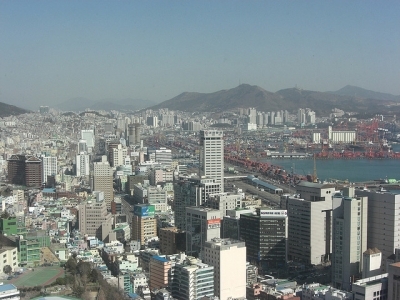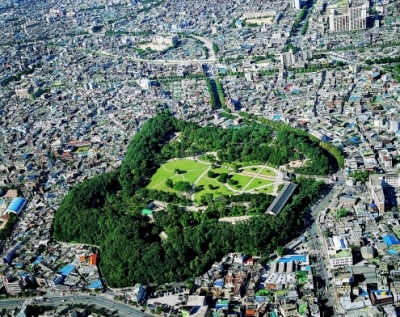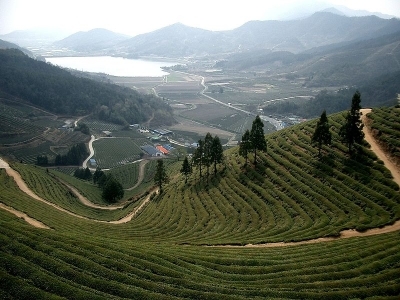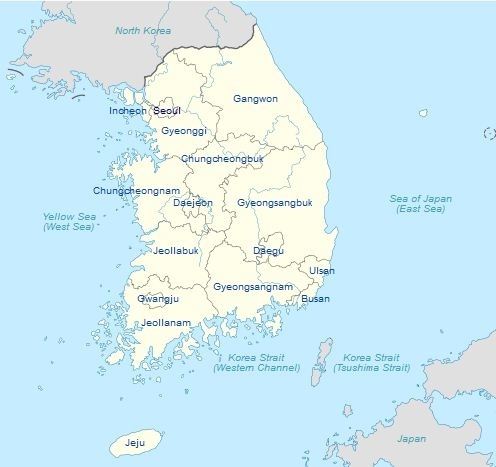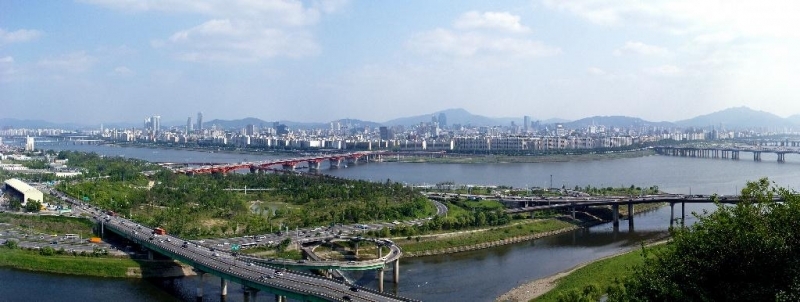South Korea
South Korea is a nation of nearly 49 million people in eastern Asia, on the southern half of the Korean Peninsula bordering the Sea of Japan (East Sea) and the Yellow Sea (West Sea)
Its major environmental issues include:
- air pollution in large cities;
- acid rain;
- water pollution from the discharge of sewage and industrial effluents; and,
- drift net fishing
There are occasional typhoons which bring high winds and floods. Low-level seismic activity is common in southwest of the country.
An independent Korean state or collection of states has existed almost continuously for several millennia. Between its initial unification in the 7th century - from three predecessor Korean states - until the 20th century, Korea existed as a single country. It became a Chinese tributary state in 1392 with the formation of the Choson Dynasty. Korea became an independent country at the conclusion of the Sino-Japanese War in 1895 with the Treaty of Shimonoseki.
Imperial Japan, following the Russo-Japanese War in 1905, forced Korea to sign the Protectorate Treaty, beginning a period of Japanese occupation. In 1910 Tokyo annexed the Peninsula. Korea regained its independence following Japan's surrender to the United States in 1945.
After World War II, a Republic of Korea (ROK) was set up in the southern half of the Korean Peninsula while a Communist-style government was installed in the north (the DPRK).
During the Korean War (1950-53), US troops and UN forces fought alongside soldiers from the ROK to defend South Korea from DPRK attacks supported by China and the Soviet Union. An armistice was signed in 1953, splitting the peninsula along a demilitarized zone at about the 38th parallel. A Military Demarcation Line within the 4-km wide Demilitarized Zone has separated North from South Korea since 1953. There are periodic incidents with North Korea in the Yellow Sea over the Northern Limit Line, which South Korea claims as a maritime boundary.
After the Korean War, South Korea under the Park Chung-hee regime achieved rapid economic growth with per capita income rising to roughly 17 times the level of North Korea.
In 1993, Kim Young-sam became South Korea's first civilian president following 32 years of military rule.
South Korea today is a fully functioning modern democracy. President Lee Myung-bak has pursued a policy of global engagement since taking office in February 2008, highlighted by Seoul's hosting of the G-20 summit in November 2010 and its scheduled hosting of the Nuclear Security Summit in March 2012 as well as the 2018 Winter Olympic Games.
Serious tensions with North Korea have punctuated inter-Korean relations in recent years, including the North's sinking of the South Korean warship Cheonan in March 2010 and its artillery attack on South Korean soldiers and citizens in November 2010.
South Korea has a strategic location on Korea Strait.
South Korea and Japan claim Liancourt Rocks (Tok-do/Take-shima), occupied by South Korea since 1954.
Contents
Geography
Location: Eastern Asia, southern half of the Korean Peninsula bordering the Sea of Japan and the Yellow Sea
Geographic Coordinates: 37 00 N, 127 30 E
Area: 99,720 sq km (land: 96,920 sq km; water: 2,800 sq km)
Land Boundaries: 238 km (North Korea)
Coastline: 2,413 km
Maritime Claims:
territorial sea: 12 nm; between 3 nm and 12 nm in the Korea Strait
contiguous zone: 24 nm
exclusive economic zone: 200 nm
continental shelf: not specified
Natural Hazards: occasional typhoons bring high winds and floods; low-level seismic activity common in southwest. volcanism: Halla (elev. 1,950 m) is considered historically active although it has not erupted in many centuries.
Terrain: mostly hills and mountains; wide coastal plains in west and south. The highest point is Halla-san (1,950 m).
Climate: temperate, with rainfall heavier in summer than winter
|
Topology of South Korea. Source: Wikimedia Commons. |
Ecology and BiodiversityMap source: World Wildlife Fund See also: |
People and Society
Population: 48,860,500 (July 2012 est.)
Korea's population is one of the most ethnically and linguistically homogenous in the world. Virtually all Koreans share a common cultural and linguistic heritage. There is a small Chinese community (about 20,000), and there are rising rates of interracial marriage. With 48.7 million people inhabiting an area roughly the size of Indiana, South Korea has one of the world's highest population densities. Major population centers are located in the northwest, southeast, and in the plains south of the Seoul-Incheon area.
Ethnic Groups: homogeneous (except for about 20,000 Chinese)
| Chungchung Puk-do Province, South Korea (Photograph by Jan Boonstra) |
| Gyeongbokgung royal palace in northern Seoul. First constructed in 1394, it was reconstructed in 1867. |
| The "Bridge of No Return" in the Demilitarized Zone (DMZ) between North and South Korea was used for prisoner exchanges at the close of the Korean War. |
| The Han River in Seoul. Source: Bobbie/Flickr |
|
Cheju Island, alternately known as Chejudo or Jejudo, is an oval-shaped volcanic landmass covering 1,845 square kilometers (712 square miles) off the southern tip of the Korean Peninsula. Geologists estimate the island’s age at 2 million years, and archaeological finds suggest that people have lived on the island since prehistoric times. Today, Cheju is both a tourist attraction and home to a United Nations Educational, Scientific and Cultural Organization (UNESCO) World Heritage site. The Enhanced Thematic Mapper Plus on NASA’s Landsat 7 satellite captured this image of Cheju Island on April 6, 2000. In this photo-like image, cloudless skies allow a clear view of the island and the swirling blue hues of the surrounding waters. Urbanized areas, such as the capital city, Cheju, appear in shades of gray-beige along the island’s perimeter. Inland, a combination of natural vegetation, cultivated fields, and bare ground creates a patchwork of tan and green. The island’s dominant feature is Halla Mountain, a volcano whose last recorded eruption occurred in the year 1007. Halla Mountain is a shield volcano with a low, broad profile resembling an ancient warrior shield. It is one of the world’s few shield volcanoes located over a magma “hotspot” on a stationary plate of continental crust. Rising to a height of 1,950 meters (6,398 feet), Halla Mountain is the highest peak in South Korea, and the volcano’s crater holds a natural lake and numerous waterfalls. Lava tubes from the volcano have formed a network of caves complete with lava walls with carbonate rock formations. The rarity of these features combined with their instructiveness about volcanic processes has earned the site its World Heritage status. Source: NASA. NASA images created by Robert Simmon, using Landsat data provided by the United States Geological Survey. Caption by Michon Scott. |
|
Nakdong River running through the Angdong region. Source: Julie Facine/Flickr. |
| Busan (formerly Pusan), the second largest city in South Korea, is located on the southeast corner of the Korean Peninsula |
|
Sediment run off into Incheon Bay, on the western coast of Soouth Korea. The city of Incheon (Inch'on), west of Seoul is also visble. |
| Dalseong park in the heart of the city of Daegu (Taegu), the fourth largest in South Korea. |
|
Green tea farm in Boseong county in the South Jeolla Province of southwest South Korea. Source: Fred Ojardias/Flckr |
Age Structure:
0-14 years: 15.7% (male 3,980,541/female 3,650,631)
15-64 years: 72.9% (male 18,151,023/female 17,400,809)
65 years and over: 11.4% (male 2,259,621/female 3,312,032) (2011 est.)
Population Growth Rate: 0.204% (2012 est.)
Birthrate: 8.42 births/1,000 population (2012 est.)
Death Rate: 6.38 deaths/1,000 population (July 2012 est.)
Net Migration Rate: 0 migrant(s)/1,000 population (2012 est.)
Korea has experienced one of the largest rates of emigration, with ethnic Koreans residing primarily in China (2.4 million), the United States (2.1 million), Japan (600,000), and the countries of the former Soviet Union (532,000).
Life Expectancy at Birth: 79.3 years
male: 76.12 years
female: 82.7 years (2012 est.)
Total Fertility Rate: 1.23 children born/woman (2012 est.)
Languages: Korean, English (widely taught in junior high and high school)
The Korean language is related to Japanese and Mongolian. Although it differs grammatically from Chinese and does not use tones, a large number of Chinese cognates exist in Korean. Chinese ideograms are believed to have been brought into Korea sometime before the second century BC. The learned class spoke Korean, but read and wrote Chinese. A vernacular writing system ("hangul") was invented in the 15th century by King Sejong to provide a writing system for commoners who could not read classical Chinese. Modern Korean uses hangul almost exclusively with Chinese characters in limited use for word clarification. Approximately 1,300 Chinese characters are used in modern Korean. English is taught as a second language in most primary and secondary schools. Chinese is also widely taught at secondary schools.
Literacy (age 15 and over can read and write): 97.9% (2002)
Urbanization: 83% of total population (2010) growing at an annual rate of change of 0.6% (2010-15 est.)
History
Korea's legendary foundation by the mythical king Tangun in BC 2333 embodies the homogeneity and self-sufficiency valued by the Korean people. Korea experienced many invasions by its larger neighbors in its 2,000 years of recorded history. The country repelled numerous foreign invasions despite domestic strife, in part due to its protected status in the Sino-centric regional political model during Korea's Joseon dynasty (1392-1910). Historical antipathies to foreign influence earned Korea the title of "Hermit Kingdom" in the 19th century.
With declining Chinese power and a weakened domestic posture at the end of the 19th century, Korea was open to Western and Japanese encroachment. In 1910, Japan began a 35-year period of colonial rule over Korea. As a result of Japan's efforts to supplant the Korean language and aspects of Korean culture, memories of Japanese annexation still recall fierce animosity and resentment, especially among older Koreans. Nevertheless, since import restrictions on Japanese movies, popular music, fashion, and the like were lifted in the 1990s, many Koreans, especially the younger generations, have eagerly followed Japanese pop culture. Aspects of Korean culture, including television shows and movies, have also become popular in Japan.
Japan's surrender to the Allied Powers in 1945, signaling the end of World War II, only further embroiled Korea in foreign rivalries. Division of the peninsula at the 38th parallel marked the beginning of Soviet and U.S. trusteeship over the North and South, respectively. On August 15, 1948 the Republic of Korea (R.O.K.) was established, with Syngman Rhee as the first President. On September 9, 1948 the Democratic People's Republic of Korea (D.P.R.K.) was established under Kim Il Sung.
On June 25, 1950, North Korean forces invaded South Korea. Led by the U.S., a 16-member coalition undertook the first collective action under United Nations Command (UNC). Following China's entry on behalf of North Korea later that year, a stalemate ensued for the final 2 years of the conflict. Armistice negotiations, initiated in July 1951, were ultimately concluded on July 27, 1953 at Panmunjom, in what is now the Demilitarized Zone (DMZ). The Armistice Agreement was signed by representatives of the Korean People's Army, the Chinese People's Volunteers, and the U.S.-led UNC. Though the R.O.K. supported the UNC, it refused to sign the Armistice Agreement. A peace treaty has never been signed. The war left almost three million Koreans dead or wounded and millions of others homeless and separated from their families.
In the following decades, South Korea experienced political turmoil under autocratic leadership. President Syngman Rhee was forced to resign in April 1960 following a student-led uprising. The Second Republic under the leadership of Chang Myon ended after only 1 year, when Major General Park Chung Hee led a military coup. Park's rule, which resulted in tremendous economic growth and development but increasingly restricted political freedoms, ended with his assassination in 1979. Subsequently, a powerful group of military officers, led by Lieutenant General Chun Doo-hwan, declared martial law and took power.
Throughout the Park and Chun eras, South Korea developed a vocal civil society that led to strong protests against authoritarian rule. Composed primarily of students and labor union activists, protest movements reached a climax after Chun's 1979 coup and declaration of martial law. A confrontation in Gwangju in 1980 left at least 200 civilians dead. Thereafter, pro-democracy activities intensified even more, ultimately forcing political concessions by the government in 1987, including the restoration of direct presidential elections.
In 1987, Roh Tae-woo, a former general, was elected president, but additional democratic advances during his tenure resulted in the 1992 election of a long-time pro-democracy activist, Kim Young-sam. Kim became Korea's first civilian elected president in 32 years. The 1997 presidential election and peaceful transition of power marked another step forward in Korea's democratization when Kim Dae-jung, a life-long democracy and human rights activist, was elected from a major opposition party. The transition to an open, democratic system was further consolidated in 2002, when self-educated human rights lawyer, Roh Moo-hyun, won the presidential election on a "participatory government" platform. In December 2007, South Koreans elected Lee Myung-bak, a former business executive and Mayor of Seoul, as president.
Korean Peninsula: Reunification Efforts
For almost 20 years after the 1950-53 Korean War, relations between North and South Korea were minimal and very strained. Official contact did not occur until 1971, beginning with Red Cross contacts and family reunification projects. In the early 1990s, relations between the two countries improved with the 1991 “Agreement on Reconciliation, Nonaggression and Exchanges and Cooperation between the South and the North,” since known as the “Basic Agreement,” which acknowledged that reunification was the goal of both governments, and the 1992 “Joint Declaration of the Denuclearization of the Korean Peninsula.” However, divergent positions on the process of reunification and North Korean weapons programs, compounded by South Korea's tumultuous domestic politics and the 1994 death of North Korean leader Kim Il Sung, contributed to a cycle of warming and cooling of relations.
Relations improved again following the 1997 election of Kim Dae-jung. His "Sunshine Policy" of engagement with the D.P.R.K. set the stage for the historic June 2000 inter-Korean summit between President Kim and North Korean leader Kim Jong-il. President Kim was awarded the Nobel Peace Prize in 2000 for the policy, but the prize was somewhat tarnished by revelations of a $500 million dollar "payoff" to North Korea that immediately preceded the summit. Engagement continued during Roh Moo-hyun’s presidency, but declined following the inauguration of President Lee Myung-bak in February 2008.
Korean Peninsula: Nuclear Tensions and Recent Developments
Relations worsened following North Korea’s acknowledgement in October 2002 of a covert program to enrich uranium for nuclear weapons. Following this acknowledgement, the United States, along with the People's Republic of China, proposed multilateral talks among the concerned parties to deal with this issue. At the urging of China and its neighbors, the D.P.R.K. agreed to meet with China and the United States in April 2003. In August of that year, the D.P.R.K. agreed to attend Six-Party Talks aimed at ending the North's pursuit of nuclear weapons that added the Republic of Korea, Japan, and Russia to the table. Two more rounds of Six-Party Talks between the United States, the Republic of Korea, Japan, China, and the D.P.R.K. were held in February and June of 2004. At the third round, the United States put forward a comprehensive proposal aimed at completely, verifiably, and irreversibly eliminating North Korea's nuclear weapons programs. A fourth round of talks was held in two sessions between July and September 2005.
A breakthrough for the Six-Party Talks came with the Joint Statement of Principles on September 19, 2005, in which, among other things, the D.P.R.K. committed to "abandoning all nuclear weapons and existing nuclear programs and returning, at an early date, to the Treaty on the Non-Proliferation of Nuclear Weapons and to IAEA safeguards." The Joint Statement also committed the United States and other parties to certain actions as the D.P.R.K. denuclearized. In addition, the United States offered security assurances to North Korea, specifying that it had no nuclear weapons on R.O.K. territory and no intention to attack or invade the D.P.R.K. with nuclear or other weapons. Finally, the United States and the D.P.R.K., as well as the D.P.R.K. and Japan, agreed to undertake steps to normalize relations, subject to their respective bilateral policies.
However, following D.P.R.K. protests against U.S. Government money-laundering sanctions on D.P.R.K. funds held at Macao’s Banco Delta Asia, the D.P.R.K. boycotted the Six-Party Talks during late 2005 and most of 2006. On October 9, 2006, North Korea announced a successful nuclear test, verified by the United States on October 11. In response, the United Nations Security Council (UNSC), citing Chapter VII of the UN Charter, unanimously adopted Resolution 1718, condemning North Korea's action and imposing sanctions on certain luxury goods and trade of military items, weapons of mass destruction (WMD)-related parts, and technology transfers.
The Six-Party Talks resumed in December 2006. Following a bilateral meeting between the United States and D.P.R.K. in Berlin in January 2007, yet another round of Six-Party Talks was held in February 2007. On February 13, 2007, the parties reached an agreement on "Initial Actions for the Implementation of the Joint Statement" in which North Korea agreed to shut down and seal its Yongbyon nuclear facility, including the reprocessing facility, and to invite back International Atomic Energy Agency (IAEA) personnel to conduct all necessary monitoring and verification of these actions. The other five parties agreed to provide emergency energy assistance to North Korea in the amount of 50,000 tons of heavy fuel oil (HFO) in the initial phase (within 60 days) and the equivalent of up to 950,000 tons of HFO in the next phase of North Korea's denuclearization. The six parties also established five working groups to form specific plans for implementing the Joint Statement in the following areas: denuclearization of the Korean Peninsula, normalization of D.P.R.K.-U.S. relations, normalization of D.P.R.K.-Japan relations, economic and energy cooperation, and a Northeast Asia peace and security mechanism. All parties agreed that the working groups would meet within 30 days of the agreement, which they did. The agreement also envisioned the directly-related parties negotiating a permanent peace regime on the Korean Peninsula at an appropriate separate forum. As part of the initial actions, North Korea invited then-IAEA Director General ElBaradei to Pyongyang in early March for preliminary discussions on the return of the IAEA to the D.P.R.K. A sixth round of Six-Party Talks took place on March 19-23, 2007, in which the parties reported on the first meetings of the five working groups.
At the invitation of the D.P.R.K., Assistant Secretary of State Christopher Hill visited Pyongyang in June 2007 as part of ongoing consultations with the six parties on implementation of the Initial Actions agreement. After the Banco Delta Asia funds were released in July 2007, the D.P.R.K. shut down the Yongbyon nuclear facility as well as an uncompleted reactor at Taechon, and IAEA personnel returned to the D.P.R.K. to monitor and verify the shutdown and to seal the facility. Concurrently, the R.O.K., China, United States, and Russia initiated deliveries of HFO and other energy-related assistance per the agreement. These four parties continued to provide shipments of HFO and other energy assistance as the D.P.R.K. implemented disablement steps during 2007 and 2008. All five working groups met in August and September 2007 to discuss detailed plans for implementation of the next phase of the Initial Actions agreement, and the D.P.R.K. invited a team of experts from the United States, China, and Russia to visit the Yongbyon nuclear facility in September 2007 to discuss specific steps that could be taken to disable the facility. The subsequent September 27-30 Six-Party plenary meeting resulted in the October 3, 2007 agreement on "Second-Phase Actions for the Implementation of the Joint Statement."
Under the terms of the October 3 agreement, the D.P.R.K. agreed to disable all existing nuclear facilities subject to abandonment under the September 2005 Joint Statement and the February 2007 agreement. The parties agreed to complete by December 31, 2007 a set of disablement actions for the three core facilities at Yongbyon: the 5-MW(e) Experimental Reactor, the Radiochemical Laboratory (Reprocessing Plant), and the Fresh Fuel Fabrication Plant. The D.P.R.K. also agreed to provide a complete and correct declaration of all its nuclear programs in accordance with the February 2007 agreement by December 31, 2007 and reaffirmed its commitment not to transfer nuclear materials, technology, or know-how.
In November 2007, the D.P.R.K. began to disable the three core facilities at Yongbyon and completed many of the agreed disablement actions by the end of the year. Assistant Secretary of State Hill visited Pyongyang again in December 2007 as part of ongoing consultations on the implementation of Second-Phase actions and carried with him a letter from President George W. Bush to Kim Jong-il. While the D.P.R.K. missed the December 31 deadline to provide a complete and correct declaration, it belatedly delivered its declaration to the Chinese on June 26, 2008. The D.P.R.K. also imploded the cooling tower at the Yongbyon facility in late June 2008 in the presence of international media and U.S. Government officials. Following the D.P.R.K.'s progress on disablement and provision of a declaration, President Bush announced the lifting of the application of the Trading with the Enemy Act (TWEA) with respect to the D.P.R.K. and notified Congress of his administration's intent to rescind North Korea's designation as a state sponsor of terrorism, a step which the Secretary of State followed through on in October 2008. However, efforts to move forward on verification steps soon met with D.P.R.K. resistance.
In April 2009, the D.P.R.K. launched a missile over the Sea of Japan, in violation of the UN Security Council Resolution (UNSCR) 1718. The UNSC issued a statement condemning the launch and demanding that the D.P.R.K. refrain from further launches. The D.P.R.K. responded by withdrawing its active participation from the Six-Party Talks and demanding the expulsion of IAEA inspectors and U.S. technical experts who had been monitoring the Yongbyon nuclear site. From May to November 2009, the D.P.R.K. announced a number of nuclear tests and short-range ballistic missile launches, announcing in September 2009 that “experimental uranium enrichment has been successfully conducted to enter into completion phase.” In June 2009, the UNSC adopted Resolution 1874, which expanded UNSCR 1718 to include a ban on arms transfers to and from the D.P.R.K., to call on states to inspect vessels in their territory when there are “reasonable grounds” that banned cargo is on a ship. The United States appointed Ambassador Philip Goldberg as the U.S. Coordinator for Implementation of UNSCR 1874. In June, July, and August 2009, Ambassador Goldberg led delegations to China, the R.O.K., Japan, Singapore, Malaysia, Thailand, Russia, the U.A.E., and Egypt to encourage these states to implement sanctions in a way that would shed light on North Korean proliferation-related activities.
In December 2009, Special Representative for North Korea Policy Stephen Bosworth led an interagency delegation to Pyongyang for extensive talks that focused on the way to achieve verifiable denuclearization of the Korean Peninsula. The United States and North Korea agreed on the importance of the Six-Party Talks and the need to implement the 2005 Joint Statement, but did not agree on when and how the D.P.R.K. would return to denuclearization talks. Prospects for talks dimmed following the D.P.R.K.’s sinking of the R.O.K. warship Cheonan on March 26, 2010, which killed 46 R.O.K. sailors. In spite of overwhelming scientific evidence that the warship was sunk by a North Korean torpedo fired from a North Korean submarine, the D.P.R.K. has continued to deny responsibility for the attack. On November 23, 2010, North Korea attacked Yeonpyeong Island with artillery, killing two civilians and wounding 13. This incident has increased complications and tensions between the North and South.
In July 2011 and October 2011, an interagency delegation led by Special Representative Bosworth met with North Korean officials in New York and Geneva, respectively, to explore the willingness of North Korea to take concrete steps toward denuclearization. The United States reiterated that the path was open to North Korea for the resumption of talks, improved relations with the United States, and greater regional stability if it demonstrated through concrete actions its support for the Six-Party process as a committed and constructive partner.
Following a third round of U.S.-D.P.R.K. bilateral talks in Beijing in February 2012, the D.P.R.K. announced moratoria on long-range missile launches, nuclear tests, and its uranium enrichment activity at Yongbyon, and agreed to allow IAEA inspectors to monitor the moratorium on uranium enrichment. Nevertheless, in March 2012, the D.P.R.K. announced plans to launch a satellite using ballistic missile technology in mid-April to commemorate the 100th anniversary of the birth of Kim Il Sung. The launch took place but was unsuccessful.
Government
The Republic of Korea (commonly known as "South Korea") is a republic with powers nominally shared among the executive, the legislature, and the judiciary, but traditionally dominated by the president. The president is chief of state and is elected for a single term of 5 years. The 299 members of the unicameral National Assembly are elected to 4-year terms; elections for the assembly were held on April 11, 2012. South Korea's judicial system comprises a Supreme Court, appellate courts, and a Constitutional Court. The judiciary is independent under the constitution. The country has nine provinces and seven administratively separate cities--the capital of Seoul, along with Busan, Daegu, Daejeon, Gwangju, Incheon and Ulsan. Political parties include New Frontier Party (NFP), Democratic United Party (DUP), Liberty Forward Party (LFP), Unified Progressive Party (UPP), Renewal Korea Party (RKP) and K Party (KP). Suffrage is universal at age 19.
Government Type: republic
Capital: Seoul 9.778 million (2009)
Other Major Cities: Busan (Pusan) 3.439 million; Incheon (Inch'on) 2.572 million; Daegu (Taegu) 2.458 million; Daejon (Taejon) 1.497 million (2009)
|
Administrative divisions: 9 provinces (do, singular and plural) and 7 metropolitan cities (gwangyoksi, singular and plural) Provinces:
Metropolitan cities:
|
Independence Date: 15 August 1945 (from Japan)
Legal System: mixed legal system combining European civil law, Anglo-American law, and Chinese classical thought. Soutj Korea has not submitted an International Court of Justice (ICJ) jurisdiction declaration; but accepts International criminal court (ICCt) jurisdiction
International Environmental Agreements
South Korea is party to international agrements on: Antarctic-Environmental Protocol, Antarctic-Marine Living Resources, Antarctic Treaty, Biodiversity, Climate Change, Climate Change-Kyoto Protocol, Desertification, Endangered Species, Environmental Modification, Hazardous Wastes, Law of the Sea, Marine Dumping, Ozone Layer Protection, Ship Pollution, Tropical Timber 83, Tropical Timber 94, Wetlands, and Whaling.
See: Greenhouse Gas Control Policies in South Korea
Seoul from the sky, June 18, 2008. Source: Michael Sotnikov/Flickr.
Water
Total Renewable Water Resources: 69.7 cu km (1999)
Freshwater Withdrawal: 18.59 cu km/yr (36% domestic, 16% industrial, 48% agricultural)
Per Capita Freshwater Withdrawal: 389 cu m/yr (2000)
See: Water profile of Republic of Korea
Agriculture
Agricultural products: rice, root crops, barley, vegetables, fruit; cattle, pigs, chickens, milk, eggs; fish
Irrigated Land: 8,320 sq km (2008)
Resources
Natural Resources: coal, tungsten, graphite, molybdenum, lead, hydropower potential
Land Use:
Economy
Over the past several decades, the Republic of Korea has achieved a remarkably high level of economic growth, which has allowed the country to rise from the rubble of the Korean War into the ranks of the Organization for Cooperation and Development (OECD). Today, South Korea is the United States' seventh-largest trading partner and is the 15th-largest economy in the world.
In the early 1960s, the government of Park Chung Hee instituted sweeping economic policy changes emphasizing exports and labor-intensive light industries, leading to rapid debt-financed industrial expansion. The government carried out a currency reform, strengthened financial institutions, and introduced flexible economic planning. In the 1970s Korea began directing fiscal and financial policies toward promoting heavy and chemical industries, consumer electronics, and automobiles. Manufacturing continued to grow rapidly in the 1980s and early 1990s.
In recent years, Korea's economy moved away from the centrally planned, government-directed investment model toward a more market-oriented one. South Korea bounced back from the 1997-98 Asian financial crisis with assistance from the International Monetary Fund (IMF), but its recovery was based largely on extensive financial reforms that restored stability to markets. These economic reforms, pushed by President Kim Dae-jung, helped Korea return to growth, with growth rates of 10% in 1999 and 9% in 2000. The slowing global economy and falling exports slowed growth to 3.3% in 2001, prompting consumer stimulus measures that led to 7.0% growth in 2002. Consumer overspending and rising household debt, along with external factors, slowed growth to near 3% again in 2003. Economic performance in 2004 improved to 4.6% due to an increase in exports, and remained at or above 4% in 2005, 2006, and 2007. With the onset of the global financial and economic crisis in the third quarter of 2008, annual GDP growth slowed to 2.3% in 2008 and just 0.2% in 2009. Growth was 6.1% in 2010.
South Korea's economic growth potential has been affected by a rapidly aging population and structural problems including the rigidity of South Korea's labor regulations, the need for more constructive relations between management and workers, the country's underdeveloped financial markets, and a general lack of regulatory transparency. Korean policy makers have been worried about diversion of corporate investment to China and other lower wage countries, and by Korea's fluctuating rates of foreign direct investment (FDI). President Lee Myung-bak was elected in December 2007 on a platform that promised to boost Korea's economic growth rate through deregulation, tax reform, increased FDI, labor reform, and free trade agreements (FTAs) with major markets. President Lee’s economic agenda necessarily shifted in the final months of 2008 to dealing with the global economic crisis. The economy responded well to a robust fiscal stimulus package and low interest rates in 2009. The landmark U.S.-Korea Free Trade Agreement (KORUS FTA) was approved by both countries’ respective legislatures in late 2011 and entered into force on March 15, 2012. The agreement is expected to boost exports by billions of dollars annually for both sides and support tens of thousands of new export-related jobs both in Korea and the United States.
North-South Economic Ties
Two-way trade between North and South Korea, which was first legalized in 1988, rose to almost $1.82 billion in 2008 before declining sharply thereafter. Until recently, South Korea was North Korea's second-largest trading partner after China. Much of this trade was related to out-processing or assembly work undertaken by South Korean firms in the Kaesong Industrial Complex (KIC). Much of the work done in North Korea has been funded by South Korea, but this assistance was halted in 2008 except for energy aid (heavy fuel oil) authorized under the Six-Party Talks. Many of these economic ties became important symbols of hope for the eventual reunification of the peninsula. For example, after the June 2000 North-South summit, the two Koreas reconnected their east and west coast railroads and roads where they cross the DMZ and improved these transportation routes. South Korean tour groups used the east coast road to travel from South Korea to Mt. Geumgang in North Korea beginning in 2003, although the R.O.K. suspended tours to Mt. Geumgang in July 2008 following the shooting death of a South Korean tourist by a D.P.R.K. soldier. Unfortunately, North-South economic ties were seriously damaged by escalating tensions following North Korea’s torpedoing of the South Korean warship Cheonan in March 2010. In April 2010, North Korea seized five properties at Mt. Geumgang owned by South Korea’s Hyundai Asan, saying that it was done to compensate for the damage the D.P.R.K. suffered due to the suspension of tours. In September 2010, South Korea suspended all inter-Korean trade with the exception of the KIC. In November 2010, North Korea attacked Yeonpyeong Island with artillery, further escalating tensions between the North and South. As of March 2012, economic ties had not seen signs of revival.
The South Korean economy's long term challenges include a rapidly aging population, inflexible labor market, and heavy reliance on exports - which comprise half of GDP.
GDP: (Purchasing Power Parity): $1.549 trillion (2011 est.)
GDP: (Official Exchange Rate): $1.164 trillion (2011 est.)
GDP- per capita (PPP): $31,700 (2011 est.)
GDP- composition by sector:
agriculture: 2.6%
industry: 39.3%
services: 58.2% (2010 est.)
Industries: electronics, telecommunications, automobile production, chemicals, shipbuilding, steel
Currency: South Korean won (KRW)
